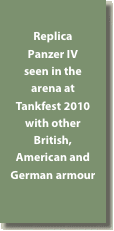
The Panzer IV, or Sonderkraftfahrzeug 161, (SdKfz 161) was the only German tank in service as a gun tank from the beginning to the end of the war. This remarkable achievement owed at least as much to the care taken over its design and development as it did to the intense pressure on German industry to simply produce tanks as the war progressed.
Clandestine experiments on tank designs had been carried out before the Nazis came to power in 1933, with the collaboration of other countries, notably Russia. So the new regime was in a position to issue detailed specifications for the new tanks it wanted very quickly.
In 1934, three companies, Rheinmetall-Borsig, M.A.N. and Krupp were contracted to produce prototypes in the so-called 20 ton class. The Krupp design was chosen in 1935, and the first production version appeared in 1936.
The first examples, (Ausf. A-C) produced up to late 1939, were essentially development vehicles, and saw modification to engines, transmissions and armour, demonstrating the deliberate process of optimising a weapon which characterised German development at least in the pre-war phase.
From then on the Panzer IV underwent almost continuous development in the light of battle experience. With the inevitable escalation of weapon design and capability as the war progressed, the Panzer IV moved from a relatively low volume (30 per battalion), close support tank to a main battle tank, with a long barrelled 75mm gun.
The first variant to carry this gun - the Ausf. F2 of 1942 - proved itself superior to all the British medium tanks it encountered in North Africa and an equal to the T34/76 in Russia. Moving to the larger gun meant significant changes to the interior layout of the tank to accommodate the much larger ammunition. It is a tribute to the sound original design that this was not only accomplished, but ammunition capacity increased at the same time without having to cut down on crew space.
With this change, the Panzer IV was essentially set and continued to be produced right up until March 1945. Before and after this point, there were continual detail changes to everything, in the interests of either production efficiency or improved performance. The L/43 gun was replaced by the L/48, increasing its hitting power. Armour was always being added to keep the tank competitive. Although it was originally intended to halt production in late 1944, it remained in production and service right to the end.
A number of the total of 8,800 produced was exported to Germany’s allies – Finland, Romania, Bulgaria and Hungary, as well as to ‘friendly’ neutrals – Turkey and Spain. Some of these continued in service well after 1945, as did examples sold to Syria after acquisition by the French and Russians. Syrian Mark IVs served in the 6 Day War of 1967.
Like its smaller sibling, the Panzer III, the IV served as the basis for a series of specialist vehicles: Jagdpanzer, Command Tanks, Anti- Aircraft tanks and engineer vehicles.
